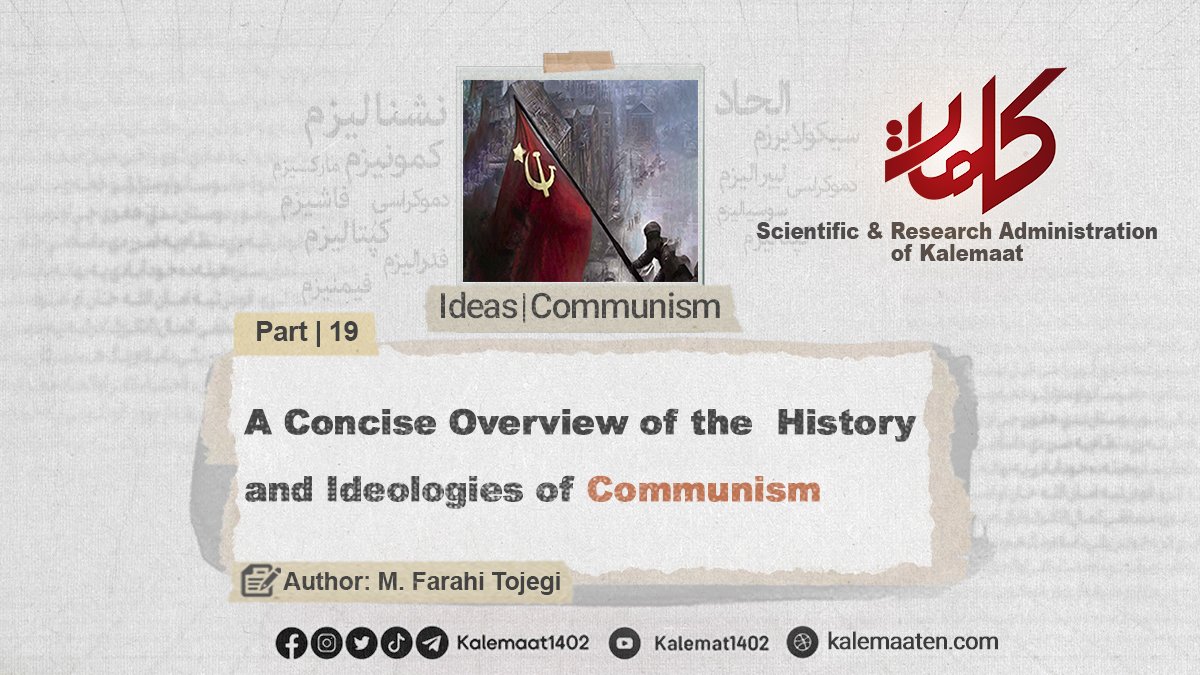Author: M. Farahi Tojegi
A Concise Overview of the History and Ideologies of Communism (the 19th and final part)
Causes of the Collapse of Communism
On December 25, 1991, the world witnessed a momentous event—an event that not only marked the collapse of one of the superpowers that emerged from World War II but also brought an end to ideological rivalries and geopolitical disputes between the Soviet Union and the United States. This effectively dissolved the East-West division in the international system and ushered in a new era in contemporary global affairs.
Mikhail Gorbachev, the last leader of the Soviet Union, led the Communist Party from 1985 to 1991. He is recognized as the architect of the Soviet Union’s collapse and the demise of communism in Eastern Europe. However, John R. Matthews, in his book The Rise and Fall of the Soviet Union, states: “Gorbachev never had such an intention, but nevertheless, through the reforms he implemented, he inevitably brought about the collapse of the USSR for its enemies.” In another of Matthews’ interpretations: “Although Gorbachev consistently proclaimed his loyalty to the Communist regime of the Soviet Union, his reforms ultimately led to its downfall.” [1]
During Gorbachev’s rule, two major keywords gained prominence in global media circles. These were his reform programs: Perestroika, meaning restructuring, and Glasnost, meaning political openness.
When Gorbachev came to power in 1985, he was fully aware of the severe problems facing the Soviet Union. Therefore, he initially introduced Perestroika (economic restructuring), and then Demokratizatsiya (limited political democratization), with a particular emphasis on Glasnost (opening the political atmosphere). However, he ultimately failed to control the criticism and dissatisfaction that Glasnost had opened the door to. Some citizens began to use this newly opened political space to support separatist nationalism. Gorbachev himself occasionally realized that Glasnost should be limited, although not as severely as some of his conservative colleagues in the Politburo. He also dealt firmly with some nationalist movements, such as in Azerbaijan in 1990 and Lithuania in 1991. However, it’s worth noting that the harsh crackdown in Lithuania may not have been directly ordered by Gorbachev; nonetheless, these measures were too little, too late, as he had already lost control of the situation.
While Glasnost caused many problems domestically, some aspects of Gorbachev’s foreign policy also played a crucial role in the collapse of communism. In line with his so-called “new political thinking,” Gorbachev sought better relations with the West. He believed that one of the main causes of the USSR’s economic woes was its financial support of other countries—support that came at the expense of Soviet citizens. This thinking had significant consequences for the fall of communism. Considering the events in Hungary in 1956 and Czechoslovakia in 1968, Gorbachev’s “Sinatra Doctrine” was initially met with caution and even skepticism in other communist countries. But when he withdrew Soviet forces from Afghanistan in January 1989 and urged Vietnam to pull out from Cambodia, Eastern European countries began to believe they were truly free to determine their own fate without Soviet interference.
There is no doubt that Gorbachev played a critical role in the fall of communist power. However, no single individual can bring about such a monumental historical event on their own. Preconditions such as the long-standing corruption and decay of communism had to exist, which become apparent through deeper investigation. Moreover, it is ironic that many of Gorbachev’s fiercest critics were also staunch critics of communism, making their stance contradictory and even hypocritical.
The world owes a debt of gratitude to Gorbachev for the relatively peaceful collapse of communist power and the end of the Cold War. It must be acknowledged that he lost control of both the Glasnost process and his (new) foreign policy in the final stages, and he never anticipated that his policies would lead to this point. Still, without Gorbachev’s policies and overall approach, the final outcome would not have happened in that time or in that form.
The Soviet Union under Gorbachev faced numerous contradictions, including the clash between Marxist economics and the free market. While capitalist market economies were gaining success in the United States and elsewhere, the USSR still clung to the theory that free markets caused problems and disasters. Soviet leaders held fast to the Marxist belief that competition in a free market leads to waste and overproduction. This insistence, according to historians and John R. Matthews, was the main reason behind the chronic shortages throughout the Soviet Union’s history.
The implementation of Glasnost and Perestroika during Gorbachev’s rule created a wave of optimism among the Soviet people, who gradually began envisioning a free society. As a result, central control over the free flow of information became impossible, and the drive for independence among Soviet satellite states became an urgent reality.
Meanwhile, another major blow to the USSR came with the revelation of the Chernobyl disaster. As the government lost control over information flow, it was revealed that a month earlier, a catastrophic nuclear accident had occurred at the Chernobyl plant on the Ukrainian border. The communists had attempted to cover up the human tragedy, as thoroughly analyzed in the article “The Chernobyl Disaster and the Explosion of Communism through the Normalization of Abnormality.”
The process of the disintegration of communism also manifested itself in the unrest of Soviet-dominated countries, which were no longer suppressed as before. By 1988, with the Soviet Union and its satellites on their last breath, many East Germans fled the country. In 1989, Hungary and Poland held free elections. Amid this chaos and the independence efforts of Eastern European countries, the Soviet army made a move that, like Gorbachev’s liberalizing policies, came too late. This move was the invasion of Lithuania in early 1991, which, according to John R. Matthews, “was ineffective due to its lateness.”
The reunification of East and West Germany also occurred in 1991, following the fall of the Berlin Wall in November 1989. In the continuation of the collapse, a notable historical moment occurred: on May 30, 1990, Boris Yeltsin became the president of Russia—not the USSR. Gorbachev, who was still formally the Soviet leader, made another failed attempt in July 1991 to stop the disintegration. He proposed a plan that included expanding the market economy, allowing religious freedom and the formation of new religious groups, and ending the Communist Party’s monopoly on power.
The final step came on December 21, 1991, when all Soviet satellite republics (except Georgia) issued a statement declaring: “The Soviet Union no longer exists.” Thus, the official death of the Soviet communist government was sealed.
However, from another perspective—regarding Gorbachev and the Communist Party leadership—the collapse can be summarized as follows: In July 1991, Gorbachev and U.S. President George H.W. Bush signed the Strategic Arms Reduction Treaty (START). Later, in a failed coup attempt in August, Gorbachev was detained at his dacha (country home), and by December, he resigned from the presidency. The Soviet Union officially ceased to exist.
Previous Part
[1]. John O. Matthews: The Rise and Fall of the Soviet Union.



